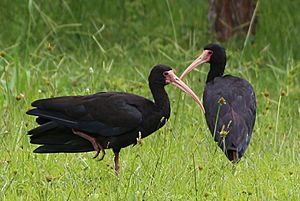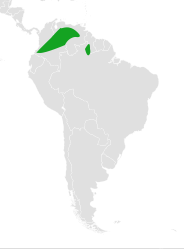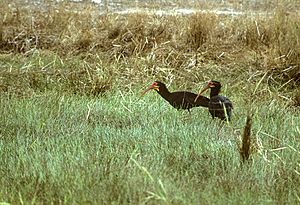Sharp-tailed ibis facts for kids
Quick facts for kids Sharp-tailed ibis |
|
|---|---|
 |
|
| Conservation status | |
| Scientific classification | |
 |
|
| Current world extant distribution according to the IUCN (2012) | |
| Synonyms | |
|
The sharp-tailed ibis (Cercibis oxycerca) is a type of ibis bird. It lives in open, wet grasslands called savannas in parts of northern South America.
Contents
About the Sharp-Tailed Ibis
The sharp-tailed ibis is the only bird in its group, called Cercibis. Scientists are still learning about its family tree. However, studies of its skull suggest it is related to spoonbills.
What Does It Look Like?
This large ibis is about 75 to 86 centimeters (30 to 34 inches) long. Male birds are a little bigger than females. Their wings are about 37 to 41 centimeters long. The bill, from its base, is around 14 to 19 centimeters long.
The sharp-tailed ibis has a very long tail, which is the longest among all ibis species alive today. Its tail is about 25 to 30 centimeters long. When the bird stands, its tail sticks out past its folded wings. When it flies, the tail goes past its legs.
Most of its feathers are black with a shiny green color. Its upper back, neck, wings, and tail can have purplish hints. The front of its head and cheeks are sometimes grayish-brown. Young birds look like adults but their feathers are not as shiny.
The bird's bill, legs, toes, and the skin on its face are orange-red. Its throat is yellowish-orange. A small feathered gray line goes from below its eye down to its lower bill. It has a soft, fuzzy crest (feathers) on the back of its head and neck. Its eyes are usually grayish-red, but can turn bright red when it's time to breed.
The sharp-tailed ibis looks a bit like other ibises that live in the same areas, such as the glossy ibis and the bare-faced ibis. But you can tell it apart by its longer tail and bigger body.
What Does It Sound Like?
This ibis is quite noisy! It makes loud, clear calls like a single or double cuk or turuck. It also makes kut and kut-kaaaoh sounds. These calls can sound like a saxophone or a toy trumpet.
When flying, it makes a long tuuut sound, or a series of cuk cuk cuk cuk. It also has a loud, nasal call that sounds like TUUR-DEE. People think the male bird makes the TUUR part, and the female answers with the DEEE part. Because of the sound of its TUUR-DEE call, local people in Spanish-speaking areas sometimes call it Tarotaro.
How Does It Fly?
The sharp-tailed ibis has a slow, heavy flight. It often flies low to the ground and only for short distances, like between nearby trees. However, they have been seen flying across large open grasslands to reach places where they rest or find food. Because its wings beat loudly, you can often hear it before you see it.
Where Does It Live?
The sharp-tailed ibis lives in wet, low-lying grasslands and along riverbanks in northern South America. This area is east of the Andes mountains, usually below 300-500 meters (about 1,000-1,600 feet) above sea level.
It can be found in Venezuela, eastern Colombia, southwestern Guyana, Brazil, and Suriname. In Venezuela, it often lives near the Orinoco and Apure rivers. In the llanos (large plains) of eastern Colombia, it lives along the Casanare and Cravo Sur rivers, and the Colombian part of the Apure River. In Brazil, it is often found northwest of the Amazon River, near the Rio Negro and Rio Branco. It also lives further west near Rio Guanco and south in northwest Mato Grosso. This ibis sometimes uses gallery forests (forests along rivers) to rest and build nests.
The sharp-tailed ibis is spread out in different areas across its home range. Even though there are many of them overall, they are not very common in specific local areas. It is considered the least common ibis in the Venezuelan llanos. However, there are more of them there during the rainy season.
This ibis usually stays away from other types of wading birds. It is mostly found in pairs (a male and a female) or in small groups of three to five birds of its own kind. Even though these ibises can be territorial, they rarely look for food alone. The two birds in a pair often have different body sizes, which suggests they are a male and a female. Groups of more than two birds seem to be a pair with their young. In groups of three, the bird thought to be the offspring is noticeably smaller and has less developed colors on its face.
Life and Habits
Food and Feeding
Like the glossy ibis, which lives in the same areas, the sharp-tailed ibis mostly finds its food on land or in very shallow water. It usually looks for food in moist soil, shallow mud, and along the edges of marshes and rice fields. Sometimes, it also feeds in shallow water that is 3 centimeters (about 1 inch) deep or less. It spends less time in water to find food compared to many other South American ibises. Among ibises in its range, only the buff-necked ibis looks for food in drier, higher places. Rarely, the sharp-tailed ibis has been seen feeding in gallery forests during the wet season.
This bird mainly finds food by touch. It walks quickly over wet soil and through shallow mud or water, poking its long bill deep into the wet ground to find prey. It can adapt to different small habitats, feeding in open areas or in short grass. Some birds have been seen with dried mud all along their bills. Its way of finding food is very similar to the glossy ibis and buff-necked ibis.
The sharp-tailed ibis mostly eats medium-sized insects, especially during the dry season. It also sometimes eats amphibians (like frogs), crustaceans (like crabs), earthworms, and snails. It probably looks for food in pairs or small groups because its insect prey is spread out in the llanos.
This ibis might move to higher feeding grounds during the wet season. These higher areas could be a safe place from the widespread flooding of the low grasslands.
Reproduction and Life Cycle
Unlike most wading birds in the llanos, this ibis breeds during the dry season, from August to February. Most other llanos birds breed in the wet season (around May to October). The sharp-tailed ibis nests alone in gallery forests. It is believed that they lay eggs from August to September, and the young birds stay with their parents until late February. The average egg is about 6.5 x 4.4 centimeters (2.6 x 1.7 inches) and weighs about 70 grams (2.5 ounces).
During a six-year study of wading birds in Masaguaral, the sharp-tailed ibis was never seen in the lowland grasslands during the dry season months of August and December. In another study, it was not seen in December and January. Its secret nesting habits probably explain why it seems to disappear from the open llanos grasslands during the breeding season.
Scientists don't know much about how these birds court each other. However, they have seen mates preening each other. One bird will gently nibble at the base of the other's bill, which might be part of their courtship. Also, larger birds have been seen preening smaller birds (thought to be their young), and the young birds sometimes gently peck back at the larger ones.
Dangers and Survival
One natural enemy of this ibis might be the black-collared hawk (Busarellus nigricollis). One time, a hawk was seen chasing a sharp-tailed ibis over a flooded marsh. The ibis flew very fast and twisted in the air, which was unusual for its normally slow flight.
Relationship with Humans
So far, this ibis has not been kept in zoos. It has also never been reported to be brought to countries outside of South America.
Conservation Status
Even though this ibis is not often seen in its savanna home, its population seems to have stayed steady since the early 1900s. There are no records of this species being traded, and its overall population is not considered to be in danger. The world population is estimated to be between 10,000 and 25,000 birds, with 6,700 to 17,000 of them being adults.
The IUCN (International Union for Conservation of Nature) has listed the sharp-tailed ibis as Least Concern since 2004. This means it is not close to being a Vulnerable species based on its population trends and how widely it lives. However, because it lives a solitary life, it could possibly decline without being noticed, as it might be hard to count them. More information about its basic life and habits is needed to protect it from future population drops.
Images for kids
See also
 In Spanish: Ibis rabudo para niños
In Spanish: Ibis rabudo para niños





